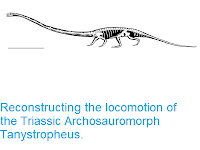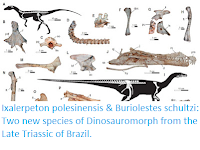Coprolites, fossil feces, can be highly useful tools to paleontologists, helping them to understand diversity and trophic relationships in ancient ecosystems, and on occasion specific animals. Coprolites can contain a variety of useful items, such as residues, microbiota and parasites, and since they often have high phosphorous levels, can mineralise rapidly after deposition, allowing the preservation of soft tissues within them that might escape preservation elsewhere - as long as those soft tissues have first survived passage through the coprolite-producers digestive system. The size and shape of coprolites can provide clues as to the animal which produced them, while examining the contents is generally accomplished by cutting them into thin sections, a destructive process which may miss some of the contents.
In a paper published in the journal Royal Society Open Science on 13 March 2019, Martin Qvarnström and Joel Vikberg Wernström of the Department of Organismal Biology at Uppsala University, Rafał Piechowski of the Institute of Paleobiology of the Polish Academy of Sciences, and the Department of Palaeobiology and Evolution at the University of Warsaw, Mateusz Tałanda, also of the Department of Palaeobiology and Evolution at the University of Warsaw, and Per Ahlberg and Grzegorz Niedźwiedzki, also of the Department of Organismal Biology at Uppsala University, describe the contents of a selection of coprolites from the Late Triassic of Krasiejów in Upper Silesia, Poland, which were scanned using propagation phase-contrast synchrotron microtomography at the European Synchrotron Radiation Facility in Grenoble, France, enabling a three dimensional reconstruction of their contents.
The Late Triassic deposits exposed at Krasiejów are about 30 m in depth, and include two fossiliferous layers, each about 1.0-1.5 m in depth. These appear to represent two separate ecosystems, with the lower one containing freshwater organisms such as Fish, Temnospondyl Amphibians, Crocodile-like Phytosaurs, and aquatic Invertebrates, while the other contains animals such as Lizard-like Sphenodonts, Silesaurid Dinosauriforms, predatort Rauisuchids, and armoured Aetosaurs. Both are thought to be Late Carnian in age (between 230 and 227 million years old).
Stratigraphic column of the Krasiejów, Upper Silesia, Poland, site. (a) Composite lithostratigraphic column compiled from exposures measured in the clay-pit with positions of bone-bearing intervals and layer with coprolites. (b), (c) Photographs of the lower (b) and upper (c) coprolite-bearing intervals. (d ) Three dimensional surface models of the studied coprolite specimens. Qvarnström et al. (2019).
Qvarnström et al. examined six coprolites from Krasiejów, three from the lower, aquatic-fauna horizon, and two from the higher, terrestrial fauna horizon, ranging from 31 to 54.5 mm in length, and 16 to 22 mm in width. These contained a variety of Arthropod fragments, including Beetle elytra, other Beetle fragments, parts of unidentified Insects, and other parts of less clear origins.
Coproliteand identified inclusions. (a) Carabid prosternum. (b) Beetle tibia. (c) Beetle tibia. (d ) Entire coprolite in semi-transparent with the identified inclusions as well as some of the indeterminable Arthropod/Insect remains (green). (e) Beetle elytra. (f ) Beetle elytra. (g) Elytron of a Polyphagan (?) Beetle. (h) Beetle elytra. (i) Fragmented large elytron. ( j) Wedge-shaped elytron. (k,l) Two Beetle pronotums. Qvarnström et al. (2019).
There is a clear correlation between the size of the coprolites and the size of the largest Arthropod fragments, although the largest fragments are far smaller than the coprolites. Qvarnström et al. suggest that this may be evidence that the coprolite-producer had a way of separating out larger fragments before they enter the lower digestive tract, possibly regurgitating them as pellets in the same way as modern Birds.
Coprolites with inclusions. (a) Concretion (semi-transparent) with internal fragmentary coprolite with inclusions. (b) A selection of six Beetle elytra. (c) A part of an Insect appendage? (d ) Enigmatic curved inclusion with denticles on the concave side. (e) Abdomen of an unknown Arthropod. (f ) Semi-transparent coprolite with highlighted inclusions. (g) Two Beetle elytra. (h) Semitransparent coprolite with highlighted inclusions. (i) Thorax plate of unknown Insect. (j) Abdomen of an unknown Arthropod (same as in e). (k) Two Beetle elytra. (l ) Semi-transparent coprolite with highlighted inclusions. (m) A bilateral structure of unknown affinity. (n) Three beetle elytra. (o) A swirl-shaped inclusion maybe representing some inner Insect structure (cf. digestion). Qvarnström et al. (2019).
All of the coprolites are of similar size and shape, and have similar contents, leading Qvarnström et al. to conclude they were all made by the same type of animal, and the absence of any Fish or Plant fragments suggests that the coprorolite producer was an Insectivore rather than a more general carnivore or herbivore. The coprolites appear to have come from a medium-sized producer, they seem to large to have come from any insectivorous Cynodont, Archosaur, or Lepidosaur likely to have been in the area, while the Phytosaurs and Temnospondyls present all show adaptations for piscavory (a diet of Fish) and the Rauisuchians appear to be to large.
The Bird-like Silesaurid Dinosauriform Silesaurus opolensis, however, would seem to be a good candidate for the coprolite-producer, being about the right size, and showing a number of characteristics that could be interpreted as evidence for an insectivorous diet (though it has been previously interpreted as a herbivore). The teeth of this species are triangular, but blunt, and irregularly distributed on the jaw. These teeth lack any of the microwear generally associated with herbivory, nor do they have the course serrations generally associated with a diet of Plants. The jaws of the species lack the capacity for much movement, something that might be expected in an animal tackling tough plant material, and the front part of the jaw is toothless, apparently having been covered by some sort of slender beak, a structure that might be useful for picking out Insects in a complex environment.
The proposed coprolite producer Silesaurus opolensis and some anatomical characters. (a) Braincase in posterior view (oc, paroccipital process; nc, neural canal). (b) Dentary bone in lateral view (bk, beak). (c) Life reconstruction of head. Drawing by Małgorzata Czaja. Qvarnström et al. (2019).
See also...
Follow Sciency Thoughts on Facebook.










